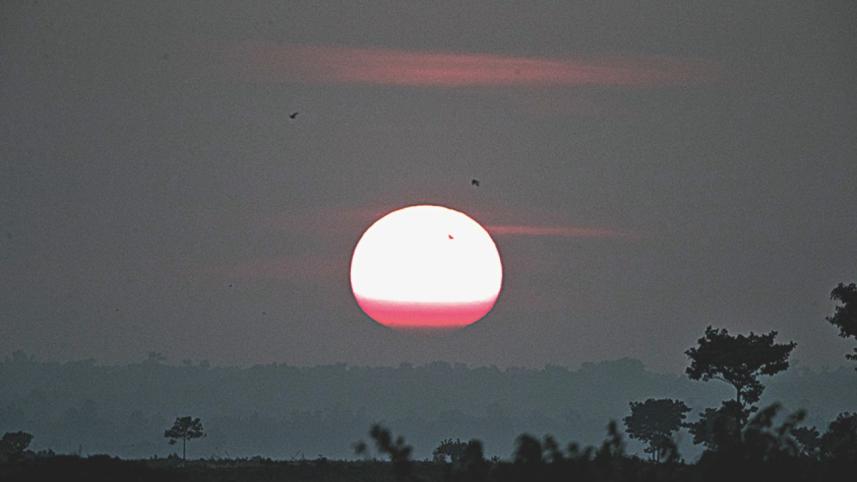Haor Sunset

I have been here in Hail Haor, Molvi Bazar, since early afternoon. The hot sun bears down on this cloudless and breezeless day. The muddy road is cracked and parched. It is the wrong time of year to look for birds, for I see only drongos, shaliks, pond herons, egrets and a few kites overhead. The more interesting and colourful birds are not here. They are en route on their long flight from northern lands and will arrive in two more months.
Still, the haor never fails to surprise. As I am standing on the bank of a fishpond, I see a mongoose scurry along the adjacent bank, its coat shining golden in the sun's rays. From about twenty feet, he sees me, freezes, fixes me with a stare of his blood-red eyes, and turns around, disappearing into a thick mess of dhol kolmi plants. He returns after a few minutes, sees me again, and bolts again. What is he up to? Perhaps he aims to enter the tin-shed of the caretaker, with its door ajar. After a third attempt he disappears into the vegetation and does not reappear.
I walk to another fishpond and stand facing east. There are miles and miles of wetlands - fishponds and rice paddies - stretching across the horizon, bounded by blue hills in the distance. Finally a breeze breaks the still air, but strangely it is almost a hot breeze, the warm exhalation of the life around me.
It is still an hour before sunset but the haor starts shutting down for the day. Birds fly home for the evening. In sudden bursts, chorui and babui, flocks of pond herons, and noisy shaliks cut across the sky. Several kites make slow circles high over a fishpond while playing with each other. Bee-eaters and swifts make a last-ditch attempt over water to catch some insects on the wing before heading for the trees. Water buffaloes gather on the roadside, satisfied with another day spent cavorting in the mud.
I wander over to one of my favourite spots, a large field facing west. The sun is now a giant red circle descending rapidly. A mile away, on a path lined by koros trees that cuts the haor north-south, farmers and workers trudge homeward, one weary step at a time. Some carry tools or baskets on their head. Guards who sleep in makeshift camps watching the fishponds start setting up for the night.
A shirtless, jeans-clad boy comes to the field and starts gathering the cows grazing there. His name is Abdus Samad. His house is on the left of my field.
I ask him about jackals. Yes, you can see them, at night or early mornings. And what about jungle cats and fishing cats? They come out late at night and catch the big fish.
By now horizon has swallowed half the sun. I turn around, negotiating my way through a wide band of water hyacinth at the field's edge. When I reach the road, the world has taken on magical colours. The sun's orange and the sky's blue reflect off the water and colours everything in shades of pink. The colours are saturated in the heat, different from winter when fog and mist mutes them. I say goodbye to the haor and start on my return journey.
(For those unfamiliar with the term, a haor is a wetland - a large, saucer-shaped depression in the land that fills up with water in monsoon and dries out in winter. Most of our larger haors are in the Sylhet region.)
facebook.com/ikabirphotographs or follow ihtishamkabir on Instagram.



 For all latest news, follow The Daily Star's Google News channel.
For all latest news, follow The Daily Star's Google News channel.
Comments